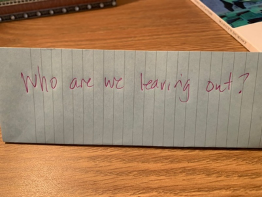We can’t help others improve equity, diversity, and inclusion in their institutions until we’ve learned how to do it for ourselves. We’re still in the early stages of our development, but we’re moving forward and documenting what we’re doing to help others as they start their journey into EDI.
Post by BCcampus’ editorial team
We want to preface this article by saying that we are not experts in matters of equity, diversity, and inclusion (EDI), and we are not trying to be experts. We’re learning what we can do — what we should do — to help everyone in B.C. enjoy access to resources and knowledge in the ways that work best for them. To quote Sonya Renee Taylor in her book The Body Is Not an Apology: The Power of Radical Self-Love, “When we liberate ourselves from the expectation that we must have all things figured out, we enter a sanctuary of empathy.”
Talking about equity, diversity, and inclusion as a primarily white organization is a challenge, but not talking about it is far worse. For change to happen, we need to get outside of our comfort zones, acknowledge that we have fragile egos and a lifetime of privilege, and take stock of where we are so we can see what needs to change.
“Our work in EDI began several years ago,” shared Mary Burgess, executive director at BCcampus. “When we started the Indigenization project, that was the first time that BCcampus had engaged in issues of racial injustice. It opened our eyes to the system, allowing us to see the inequalities and barriers preventing people from accessing the information and knowledge they need and want in the ways that work for them. Since then, we’ve learned much about Indigenous Peoples and Indigenous engagement, guiding us through the first steps of our EDI journey.”
“Our mandate at BCcampus,” explained Amanda Coolidge, director of Open Education, “is to ensure students throughout the province are successful in their learnings. We know that the majority of leadership positions across the post-secondary institutions of B.C. are held by cisgender people, primarily of white, European, colonial descent. Some much-needed diversity in leadership would bring more representation across faculty, staff, and students, enabling us to meet the needs of people across the province.”
Creating a Baseline
BCcampus engaged Cicely Blain Consulting to complete an equity, diversity and inclusion audit mid-2020. The report they delivered shows that, while BCcampus is EDI-aware in some areas, there is still much room for improvement. Unconscious biases, such as heteronormativity and cisnormativity, manifested in the report as they did in other areas. The report revealed that we are routinely, in our words and actions, creating an environment that is not as inclusive as it could be.
“The audit gave us much-needed perspective for practices we might not have identified on our own,” explained Amanda. “It brought attention to many things, such as our hiring practices, how we can craft our job descriptions to be more inclusive, and offered recommendations to improve our web and social media presence to engage better with everyone.”
Baby Steps
“The report based on learnings from the audit revealed many opportunities for us to improve,” shared Amanda, “but it did highlight that much of our internal diversity stems from the people we’ve most recently hired. It’s essential to have a wide variety of perspectives and lived experiences to help us make informed decisions to share with the system, and the self-learning that has taken place — and continues to — is something we can be proud of.”
“We’ve created an EDI learning group, led by Amanda,” said Mary. “We invited whoever wanted to be part of the learning team to join us. It’s not an advisory group, as we don’t yet know where we’re going or what we’re doing, but we needed to start the process of unlearning, so we can find out how to do things in a better way.”
Who Are We Leaving Out?

“Every day, as educators, we make decisions that exclude some of the students we’re teaching,” shared Mary. “We strive to hit the ‘ideal learning settings,’ but in reality, they’re ideal for almost no one. We need to start asking the question, ‘Who are we leaving out, and am I okay with that?’ When we design an online course but neglect to include alt-tags on the images, we’re saying that it’s okay that students with visual disabilities don’t have access to them. When we hold an exam in a gym filled with 250 plus students, we’re saying to those who have anxieties in those settings that prevent their best work, that that doesn’t matter. At BCcampus, we need to rethink learning design and recognize individually that our lived experience as a middle-aged, highly educated white person is actually uncommon. We have to learn about the people in our communities, and design learning that works for everyone.”
Notable Quote
“There is no endpoint for equity, diversity, and inclusion work, nor for other avenues of inclusion, such as decolonization or Universal Design for Learning. They’re all aspects and perspectives that must become part of the fabric of the post-secondary system.”
—Mary Burgess, executive director, BCcampus
